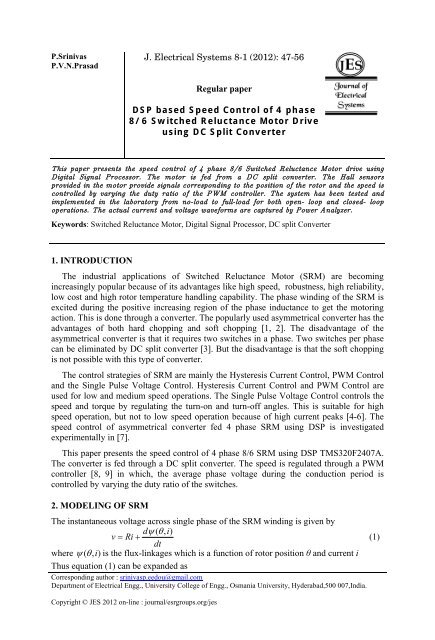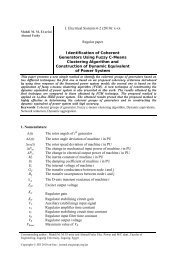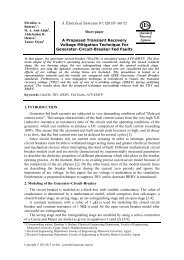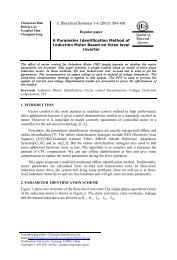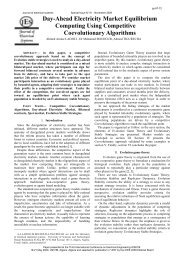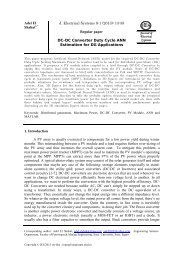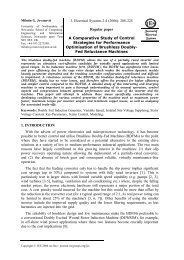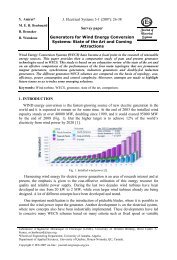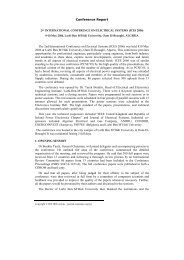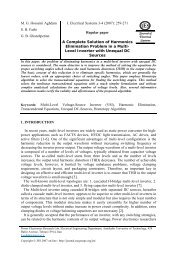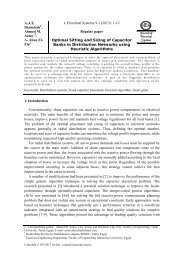Regular paper DSP based Speed Control of 4 phase 8/6 Switched ...
Regular paper DSP based Speed Control of 4 phase 8/6 Switched ...
Regular paper DSP based Speed Control of 4 phase 8/6 Switched ...
You also want an ePaper? Increase the reach of your titles
YUMPU automatically turns print PDFs into web optimized ePapers that Google loves.
P.Srinivas<br />
P.V.N.Prasad<br />
J. Electrical Systems 8-1 (2012): 47-56<br />
<strong>Regular</strong> <strong>paper</strong><br />
<strong>DSP</strong> <strong>based</strong> <strong>Speed</strong> <strong>Control</strong> <strong>of</strong> 4 <strong>phase</strong><br />
8/6 <strong>Switched</strong> Reluctance Motor Drive<br />
using DC Split Converter<br />
This <strong>paper</strong> presents the speed control <strong>of</strong> 4 <strong>phase</strong> 8/6 <strong>Switched</strong> Reluctance Motor drive using<br />
Digital Signal Processor. The motor is fed from a DC split converter. The Hall sensors<br />
provided in the motor provide signals corresponding to the position <strong>of</strong> the rotor and the speed is<br />
controlled by varying the duty ratio <strong>of</strong> the PWM controller. The system has been tested and<br />
implemented in the laboratory from no-load to full-load for both open- loop and closed- loop<br />
operations. The actual current and voltage waveforms are captured by Power Analyzer.<br />
Keywords: <strong>Switched</strong> Reluctance Motor, Digital Signal Processor, DC split Converter<br />
1. INTRODUCTION<br />
The industrial applications <strong>of</strong> <strong>Switched</strong> Reluctance Motor (SRM) are becoming<br />
increasingly popular because <strong>of</strong> its advantages like high speed, robustness, high reliability,<br />
low cost and high rotor temperature handling capability. The <strong>phase</strong> winding <strong>of</strong> the SRM is<br />
excited during the positive increasing region <strong>of</strong> the <strong>phase</strong> inductance to get the motoring<br />
action. This is done through a converter. The popularly used asymmetrical converter has the<br />
advantages <strong>of</strong> both hard chopping and s<strong>of</strong>t chopping [1, 2]. The disadvantage <strong>of</strong> the<br />
asymmetrical converter is that it requires two switches in a <strong>phase</strong>. Two switches per <strong>phase</strong><br />
can be eliminated by DC split converter [3]. But the disadvantage is that the s<strong>of</strong>t chopping<br />
is not possible with this type <strong>of</strong> converter.<br />
The control strategies <strong>of</strong> SRM are mainly the Hysteresis Current <strong>Control</strong>, PWM <strong>Control</strong><br />
and the Single Pulse Voltage <strong>Control</strong>. Hysteresis Current <strong>Control</strong> and PWM <strong>Control</strong> are<br />
used for low and medium speed operations. The Single Pulse Voltage <strong>Control</strong> controls the<br />
speed and torque by regulating the turn-on and turn-<strong>of</strong>f angles. This is suitable for high<br />
speed operation, but not to low speed operation because <strong>of</strong> high current peaks [4-6]. The<br />
speed control <strong>of</strong> asymmetrical converter fed 4 <strong>phase</strong> SRM using <strong>DSP</strong> is investigated<br />
experimentally in [7].<br />
This <strong>paper</strong> presents the speed control <strong>of</strong> 4 <strong>phase</strong> 8/6 SRM using <strong>DSP</strong> TMS320F2407A.<br />
The converter is fed through a DC split converter. The speed is regulated through a PWM<br />
controller [8, 9] in which, the average <strong>phase</strong> voltage during the conduction period is<br />
controlled by varying the duty ratio <strong>of</strong> the switches.<br />
2. MODELING OF SRM<br />
The instantaneous voltage across single <strong>phase</strong> <strong>of</strong> the SRM winding is given by<br />
dψ<br />
( θ,<br />
i)<br />
v = Ri +<br />
dt<br />
where ψ ( θ,<br />
i)<br />
is the flux-linkages which is a function <strong>of</strong> rotor position θ and current i<br />
Thus equation (1) can be expanded as<br />
Corresponding author : srinivasp.eedou@gmail.com<br />
Department <strong>of</strong> Electrical Engg., University College <strong>of</strong> Engg., Osmania University, Hyderabad,500 007,India.<br />
Copyright © JES 2012 on-line : journal/esrgroups.org/jes<br />
(1)
P. Srinivas & P. V. N. Prasad: <strong>DSP</strong> <strong>based</strong> <strong>Speed</strong> <strong>Control</strong> <strong>of</strong> 4 ph. 8/6 <strong>Switched</strong> Reluctance Motor...<br />
∂ψθ ( , i) di ∂ψθ ( , i)<br />
dθ<br />
v = Ri+ +<br />
∂t dt ∂θ<br />
dt<br />
(2)<br />
Multiplying both sides <strong>of</strong> equation (1) with i, gives an expression for instantaneous power<br />
in SRM motor as<br />
2 dψ<br />
( θ,<br />
i)<br />
vi = Ri + i<br />
(3)<br />
dt<br />
dψ<br />
( θ,<br />
i)<br />
dW dW f<br />
i =<br />
m +<br />
dt dt dt<br />
where W m , W f are mechanical energy and magnetic field energy respectively.<br />
The mechanical power can be written as product <strong>of</strong> torque and speed and is given by<br />
dW m dθ<br />
= Tω = T<br />
dt<br />
dt<br />
Where T is the torque in Nm and ω is the speed in rad/sec<br />
Substitution <strong>of</strong> equation (5) into equation (4) gives<br />
dψ<br />
( θ,<br />
i)<br />
dθ<br />
dW f<br />
i = T +<br />
dt dt dt<br />
Rearranging the equation (6) for torque gives<br />
dψ<br />
( θ,<br />
i)<br />
dW f ( θ,<br />
ψ )<br />
T ( θ,<br />
ψ ) = i(<br />
θ,<br />
ψ ) −<br />
dθ<br />
dθ<br />
For constant flux the equation (7) simplifies to<br />
∂W f<br />
T = −<br />
(8)<br />
∂θ<br />
It is <strong>of</strong>ten desirable to express torque in terms <strong>of</strong> current rather than flux, it is common to<br />
express torque in terms <strong>of</strong> co-energy, Wc<br />
∂W T = c<br />
∂θ<br />
3. DC SPLIT CONVERTER<br />
The <strong>phase</strong> winding is excited through DC split converter. The DC link voltage is split<br />
with capacitors. A disadvantage is that s<strong>of</strong>t chopping is not possible and balance must be<br />
carefully maintained between the <strong>phase</strong>s, but the circuit successfully achieves the minimum<br />
<strong>of</strong> one transistor per <strong>phase</strong> without adding extraneous passive components or sacrificing<br />
control flexibility or efficiency.<br />
The four <strong>phase</strong> DC split converter is shown in Figure. 1(a). When T 1 is turned on,<br />
current flows through T 1 and <strong>phase</strong> A. When C 2 charges, C 1 gets discharged. This is called<br />
mode 1 and shown in Figure. 1(b). When T 1 is turned <strong>of</strong>f, the current in <strong>phase</strong> A flows<br />
through C 2 and D 2. The capacitor C 2 is charged again and voltage across C 2 (V c2 ) increases<br />
further. This is called mode 2 and is shown in Figure. 1(c). A similar procedure occurs<br />
when <strong>phase</strong>s B, C and D are excited. During the normal operation, the conducting <strong>phase</strong><br />
shift between the upper leg and the lower leg and the capacitors are charged and discharged<br />
in turn. The operational waveforms <strong>of</strong> the converter are shown in Fig. 2.<br />
(4)<br />
(5)<br />
(6)<br />
(7)<br />
48
J. Electrical Systems 8-1 (2012): 47-56<br />
5. BLOCK DIAGRAM OF THE DRIVE/ EXPERIMENTAL SETUP<br />
The whole setup consists <strong>of</strong> following important units viz TMS320F2407A <strong>DSP</strong><br />
<strong>Control</strong>ler, IGBT Intelligent Power Module (IPM), SRM, Signal Conditioner and<br />
Mechanical loading arrangement. The interconnections <strong>of</strong> these units are shown in the<br />
block schematic diagram <strong>of</strong> Figure. 3. The IPM consists <strong>of</strong> a single <strong>phase</strong> bridge rectifier<br />
with capacitors at the output. This rectifier provides the rectified DC voltage to the IGBT<br />
<strong>based</strong> DC spilt converter. The IPM is rated for 25A, 1200V. Hall Effect transducers are<br />
used to sense the dc link current, dc link voltage and the output currents <strong>of</strong> the converter.<br />
The heart <strong>of</strong> the closed loop control scheme is the <strong>DSP</strong> controller. The inputs to the <strong>DSP</strong><br />
are provided through 26 pin connector. The various analog inputs to the <strong>DSP</strong> are dc link<br />
current I DC , dc link voltage V DC , the four <strong>phase</strong> currents <strong>of</strong> the DC split converter I 1 , I 2 , I 3<br />
and I 4 . These are given through signal conditioner block. The rotor position is sensed by<br />
Hall sensors and signals are given to the <strong>DSP</strong>.<br />
6. SOFTWARE IMPLEMENTATION<br />
An assembly language program was developed to operate the SRM in closed loop mode.<br />
The program generates PWM signals which are applied to the IGBTs <strong>of</strong> the converter. The<br />
motor is protected against over/under voltage, over current and rise in temperature by<br />
s<strong>of</strong>tware. The reference speed is given as an input through an external potentiometer which<br />
is interfaced to the inbuilt analog to digital converter (ADC) <strong>of</strong> the <strong>DSP</strong>. The program at<br />
start features the following tasks: (a) Initialization <strong>of</strong> all registers <strong>of</strong> <strong>DSP</strong> and resetting<br />
watchdog (b) Configuring the MUX control register, ADC, timer control registers in the<br />
Event Manager (c) Initialization <strong>of</strong> all the variables (d) Enabling <strong>of</strong> timer interrupts and<br />
watchdog (e) Hall sensor encoder is set at 00 (f) Low duty cycle <strong>of</strong> PWMs for s<strong>of</strong>t start<br />
action <strong>of</strong> motor. After the s<strong>of</strong>t start action, the duty cycle <strong>of</strong> PWM signals are varied by the<br />
program to achieve the required speed. In closed-loop control mode, the ADC <strong>of</strong> the <strong>DSP</strong> is<br />
configured to capture reference and feedback signals. After evaluating the error and<br />
amplifying it, the duty ratio <strong>of</strong> the PWM is varied to implement PWM control. The<br />
switching frequency <strong>of</strong> the converter is maintained at 20 kHz. The flow chart for open-loop<br />
and closed-loop operation is shown in Figure. 4.<br />
7. RESULTS<br />
The <strong>DSP</strong> controlled SRM drive was operated from no-load to full-load in open-loop and<br />
closed-loop modes. The open-loop and closed-loop performance <strong>of</strong> the drive is tested at<br />
three different speeds 500 rpm, 2000 rpm and 4000 rpm for different loading conditions.<br />
The variations <strong>of</strong> voltage, current, torque and efficiency on motor side are recorded at<br />
different loads using Power Analyzer. The open loop performance <strong>of</strong> the drive at three<br />
different speeds is tabulated in Table I, Table II and Table III. The closed-loop performance<br />
<strong>of</strong> the drive is also tested at the same speeds and is tabulated in Table IV, Table V and<br />
Table VI. Figure 5 shows the plot between speed and torque in open-loop and closed-loop<br />
operations. Specifications <strong>of</strong> the SRM are given in Appendix.<br />
49
P. Srinivas & P. V. N. Prasad: <strong>DSP</strong> <strong>based</strong> <strong>Speed</strong> <strong>Control</strong> <strong>of</strong> 4 ph. 8/6 <strong>Switched</strong> Reluctance Motor...<br />
T 1<br />
T 3<br />
C 1<br />
D 1<br />
D 3<br />
Fig. 1 (a) DC Split Converter (b) Mode 1 (c) Mode 2 (d) Operational waveforms <strong>of</strong> the<br />
con verter<br />
A<br />
C<br />
V dc<br />
D 2<br />
B<br />
D 4<br />
D<br />
C 2<br />
T 2<br />
T 4<br />
(a)<br />
T 1<br />
T 3<br />
C 1<br />
D 1<br />
D 3<br />
A<br />
C<br />
V dc<br />
D 2<br />
B<br />
D 4<br />
D<br />
C 2<br />
T 2<br />
T 4<br />
(b)<br />
T 1<br />
T 3<br />
C 1<br />
D 1<br />
D 3<br />
A<br />
C<br />
V dc<br />
D 2<br />
B<br />
D 4<br />
D<br />
C 2<br />
T 2<br />
T 4<br />
(c)<br />
Figure 1: (a) DC Split Converter (b) Mode 1 (c) Mode 2<br />
50
J. Electrical Systems 8-1 (2012): 47-56<br />
Figure 2: Operational waveforms <strong>of</strong> the converter<br />
P<br />
N<br />
Bridge<br />
Rectifier<br />
DC Split<br />
Converter<br />
SRM<br />
Opto<br />
Coupler<br />
Current<br />
Sensor<br />
<strong>DSP</strong><br />
Signal<br />
Conditioner<br />
Hall Sensor<br />
Figure 3: Block Diagram <strong>of</strong> <strong>Control</strong> Scheme<br />
The voltage applied to the motor remains constant in open -loop condition, whereas it<br />
increases linearly in closed-loop condition in order to compensate the impedance drop and<br />
to maintain speed at constant value. In closed-loop operation there is no change in speed<br />
from no-load to full load, whereas, in open-loop operation the speed regulation is about<br />
30%. Waveforms <strong>of</strong> the <strong>phase</strong> currents, voltage across the windings and numerical values<br />
captured by the Power analyzer when the drive is operating in closed loop running at rated<br />
load is shown in Figure 6 . When the drive is operating at rated load the speed is<br />
maintained at 4000 rpm. Enlarged view <strong>of</strong> the voltage and current in one <strong>phase</strong> in closedloop<br />
when the motor is speed is maintained at 4002 rpm under load condition is shown in<br />
Figure. 7.<br />
51
P. Srinivas & P. V. N. Prasad: <strong>DSP</strong> <strong>based</strong> <strong>Speed</strong> <strong>Control</strong> <strong>of</strong> 4 ph. 8/6 <strong>Switched</strong> Reluctance Motor...<br />
CONCLUSIONS<br />
The <strong>DSP</strong> <strong>based</strong> speed control <strong>of</strong> 4 <strong>phase</strong> 8/6 SRM is analyzed. The performance <strong>of</strong> the<br />
drive is tested in open-loop and closed-loop conditions at different loads with DC split<br />
converter. The waveforms <strong>of</strong> the <strong>phase</strong> currents, <strong>phase</strong> voltages and various associated<br />
numerical values are captured by Power Analyzer. It is observed that the speed regulation<br />
in open-loop is 25% to 30% and it is almost zero in closed-loop condition at different loads.<br />
REFERENCES<br />
[1] R.Krishnan, <strong>Switched</strong> Reluctance Motor Drives: modeling, simulation, analysis, design, and<br />
applications, CRC press, 2001.<br />
[2] T.J.E.Miller, Electronic <strong>Control</strong> <strong>of</strong> <strong>Switched</strong> Reluctance Motor, Newnes, 2001.<br />
[3] Y.Liu and P.Pillay, A Startup <strong>Control</strong> Algorithm for the Split-Link Converter for a <strong>Switched</strong><br />
Reluctance Motor Drive, IEEE Transactions on industrial Electronics, vol. 46, no.3, June 1999.<br />
[4] F.Soares, et al.,”Simulation <strong>of</strong> a 6/4 <strong>Switched</strong> Reluctance Motor <strong>based</strong> on Matlab/Simulink<br />
environment,” IEEE Trans. Aerospace and Electronic Systems, 2001.<br />
[5] A.V.Rajarathnam, et al. “Improvement <strong>of</strong> hysteresis control in switched reluctance motor<br />
drives,” IEEE International Conference on Electrical Machines and Drives, pp. 537-539,<br />
1999.<br />
[6] P.Srinivas and P.V.N.Prasasd., “Voltage <strong>Control</strong> and Hysteresis Current <strong>Control</strong> <strong>of</strong> a 8/6<br />
<strong>Switched</strong> Reluctance Motor,” in proceedings <strong>of</strong> IEEE International Conference on Electrical<br />
Machines & Systems, pp. 1557-1562, 2007.<br />
[7] P.Chancharoensook and M.F.Rahman, A <strong>DSP</strong> <strong>based</strong> <strong>Speed</strong> control <strong>of</strong> a four <strong>phase</strong> 8/6 switched<br />
Reluctance Motor Drive, Proceedings <strong>of</strong> Austrialian Universities Power Engineering<br />
Conference(AUPEC), 2004.<br />
[8] Baiming Shao et al., “A digital PWM control for <strong>Switched</strong> Reluctance Motor drives,” in<br />
proceedings <strong>of</strong> IEEE International Conference on Vehicle Power and Propulsion, pp. 1-6,<br />
2010.<br />
[9] Rik De Doncker, Duco W.J.Pulle,Andre Veltman, Advanced Electrical Drives: Analysis,<br />
Modeling and <strong>Control</strong>, Springer, 2011.<br />
52
J. Electrical Systems 8-1 (2012): 47-56<br />
Figure 4: Flow chart <strong>of</strong> the open-loop and closed-loop operation <strong>of</strong> the drive<br />
53
P. Srinivas & P. V. N. Prasad: <strong>DSP</strong> <strong>based</strong> <strong>Speed</strong> <strong>Control</strong> <strong>of</strong> 4 ph. 8/6 <strong>Switched</strong> Reluctance Motor...<br />
4500<br />
4000<br />
3500<br />
3000<br />
<strong>Speed</strong> (rpm)<br />
2500<br />
2000<br />
1500<br />
1000<br />
500<br />
0<br />
closed-loop4000<br />
open-loop4000<br />
closed-loop2000<br />
open-loop2000<br />
closed-loop500<br />
open-loop500<br />
0 0.2 0.4 0.6 0.8 1 1.2<br />
Torque (Nm)<br />
Figure 5: Variation <strong>of</strong> speed with torque in open-loop and closed loop<br />
conditions.<br />
Appendix<br />
SRM Specifications<br />
Voltage:<br />
Power:<br />
Torque:<br />
Current:<br />
<strong>Speed</strong>:<br />
48 V<br />
1.1 HP<br />
1.2 Nm<br />
10 A<br />
6000 rpm<br />
Table. I : Performance <strong>of</strong> the drive under open-loop at 500 rpm<br />
Sl.No. V mean (V) V rms (V) I mean (A) I rms (A) T (Nm) N (rpm)<br />
1 22.78 26.32 1.32 1.70 0.15 500<br />
2 22.60 25.41 4.97 6.21 0.53 450<br />
3 23.12 25.55 7.51 9.32 0.80 400<br />
4 23.04 24.82 8.51 10.52 1.01 350<br />
Table. II : Performance <strong>of</strong> the drive under open-loop at 2000 rpm<br />
Sl.No. V mean (V) V rms (V) I mean (A) I rms (A) T (Nm) N (rpm)<br />
1 22.50 25.58 1.40 1.77 0.15 2000<br />
2 24.53 27.00 5.42 6.64 0.53 1800<br />
3 24.14 25.77 8.22 9.92 0.80 1600<br />
4 24.28 25.72 9.56 11.52 1.01 1500<br />
Table. III : Performance <strong>of</strong> the drive under open-loop at 4000 RPM<br />
Sl.No. V mean (V) V rms (V) I mean (A) I rms (A) T (Nm) N (rpm)<br />
1 23.35 26.36 1.48 1.85 0.15 4000<br />
2 26.72 28.73 5.78 6.87 0.53 3600<br />
3 26.93 28.31 8.64 10.04 0.80 3200<br />
4 26.10 28.10 9.66 11.82 1.01 3000<br />
54
J. Electrical Systems 8-1 (2012): 47-56<br />
Table. IV : Performance <strong>of</strong> the drive under closed-loop at 500 rpm<br />
Sl.No. V mean (V) V rms (V) I mean (A) I rms (A) T (Nm) N (rpm)<br />
1 23.22 26.90 1.42 1.78 0.15 502<br />
2 21.85 25.34 5.13 6.38 0.53 502<br />
3 20.91 23.34 8.03 9.99 0.80 502<br />
4 20.79 23.36 8.69 10.70 1.01 502<br />
Table. V : Performance <strong>of</strong> the drive under closed-loop at 2000 rpm<br />
Sl.No. V mean (V) V rms (V) I mean (A) I rms (A) T (Nm) N (rpm)<br />
1 21.79 25.46 1.51 1.93 0.15 2003<br />
2 23.46 26.23 5.49 6.67 0.53 2003<br />
3 22.81 24.69 8.62 9.10 0.80 2003<br />
4 24.06 25.83 9.83 10.08 1.01 2003<br />
Table. VI : Performance <strong>of</strong> the drive under closed-loop at 4000 rpm<br />
Sl.No. V mean (V) V rms (V) I mean (A) I rms (A) T (Nm) N (rpm)<br />
1 22.44 26.01 1.65 2.06 0.15 4002<br />
2 26.29 28.19 6.14 7.08 0.53 4002<br />
3 26.11 27.40 9,39 10.65 0.80 4002<br />
4 25.50 26.55 9.76 11.09 1.01 4002<br />
(a)<br />
(b<br />
55
P. Srinivas & P. V. N. Prasad: <strong>DSP</strong> <strong>based</strong> <strong>Speed</strong> <strong>Control</strong> <strong>of</strong> 4 ph. 8/6 <strong>Switched</strong> Reluctance Motor...<br />
Figure 6: Performance <strong>of</strong> the drive in closed-loop at 4000 rpm under load<br />
condition (a) Current in four <strong>phase</strong>s (b) Voltage across four <strong>phase</strong> windings<br />
(c) Numerical Values<br />
Figure 7: Enlarged view <strong>of</strong> the voltage and current in one <strong>phase</strong> in closed<br />
loop at 4000 rpm under load condition.<br />
56


